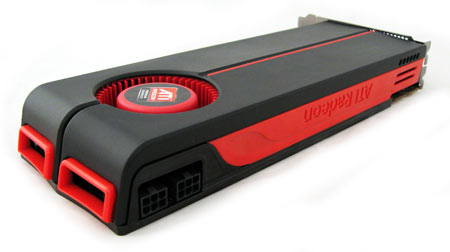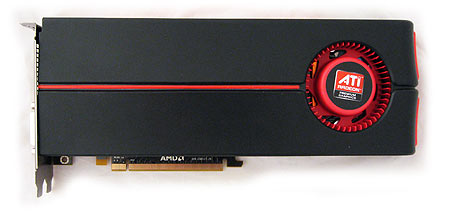ATI Radeon HD 5830: Bridging The 5700- And 5800- Price Gap
Conclusion
With the introduction of its Radeon HD 5830, AMD has now filled the most obvious price gap in its DirectX 11-capable lineup. The company has also given us another powerful card that takes the torch from the Radeon HD 4890, as it is sent out to pasture.
Incredibly similar gaming performance makes comparisons between the Radeon HD 5830 and Radeon HD 4890 easy. The similarities don't end there, as both cards were launched at similar price points. Almost certainly, given enough time and (hopefully) some competition, the Radeon HD 5830 will drop in price and deliver the same price/performance ratio that the Radeon HD 4890 has spoiled us with. And let us not forget that the 5830 delivers more than game performance alone. It uses half the idle power of the Radeon HD 4890, notably less power under load, and supplies us with all of the Radeon HD 5000-series goodies that make these new cards such an attractive prospect. Of course we're talking about Eyefinity triple-monitor gaming, bitstreaming high-def Blu-ray audio over HDMI, and DirectX 11 compatibility. On top of that the reference card is notably quieter than the 4890, although there is a compromise that has been made in the large size of the card.
What's the worst thing we can say about the new Radeon HD 5830? Well, its launch price is $80 higher than most of the Radeon HD 5770 cards in the wild, and only $60 less than most of the Radeon HD 5850s available. Based on relative performance, this relationship should probably be reversed, as the new card performs much closer to the 5770 than the 5850. On top of that, we've been spoiled by the Radeon HD 4890 delivering a solid level of performance at $200 for months now, so spending an extra $40 for performance at the same level doesn't inspire us. The market dictates what it will bear, but with Radeon HD 4890s disappearing, it won't be possible to make comparisons for long.
Pricing concerns aside, the Radeon HD 5830 is a strong performer armed with the universal feature set we've seen from all Radeon HD 5000-series cards thus far, specializing in quiet operation and moderate power usage. It ups the ante compared to the Radeon HD 5770 with almost twice the memory bandwidth; this can be a solid boon in some scenarios.
AMD is undoubtedly making a killing with its monopoly on DirectX 11-class cards, but Nvidia hasn't thrown in the towel yet. We can only hope that its upcoming answer to the Radeon 5000-series (expected to begin rolling out at the end of March) will add some flavor and choice to the market. Until then, AMD has an unbeatable selection of cards in its hand. You might even call it a royal flush, and if the dual-GPU flagship Radeon HD 5970 is a performance ace, this Radeon HD 5830 is its jack.
If you want to know more about the features defining the Radeon HD 5000-series cards, please check our other reviews below (particularly the Radeon HD 5870 article, which was the first in the series).
Radeon HD 5970
Radeon HD 5870
Radeon HD 5850
Radeon HD 5770
Radeon HD 5750
Radeon HD 5670
Radeon HD 5570
Radeon HD 5450
Get Tom's Hardware's best news and in-depth reviews, straight to your inbox.
Current page: Conclusion
Prev Page Power, Temperature, And Noise BenchmarksDon Woligroski was a former senior hardware editor for Tom's Hardware. He has covered a wide range of PC hardware topics, including CPUs, GPUs, system building, and emerging technologies.
-
jomofro39 I love my 4890. I am sad they are disappearing, because I planned on getting a x-fire thing going in the next few months, and now I have to just try and get two 5770s and sell the 4890 I have now, obviously, so I can grab some DX11! Hurray for progress!Reply -
meluvcookies I was hoping this would be just a bit cheaper such that the 5850 could finally come down nearer it's original MSRP. Unfortunately, it doesn't look like we'll see those adjustments until closer to the summer.Reply -
4745454b To much money for such little card. Performance wise its just a really expensive 4890. A good buy at $200, but $240 is to much. Might as well pony up the extra $60 and get the 5850. 5810 is a bit more like it.Reply -
flyinfinni seems more like a 5790 than a 5830 to me... Still- they are filling in the line quite well, and its gonna be interesting to see how Nvidia's new line will compare.Reply -
intelx im a little disappointed about this one, i mean 239 and yet the 4890 is $40 cheaper and beats it in some new games, i was really hoping for better performance form the 5830, now after reading this, im leaning towards either 5770 in crossfire or single 5850.Reply
man ati is kicking Nvidia in every corner right now, all the way from low end to the high end 5970! -
intelx im a little disappointed about this one, i mean 239 and yet the 4890 is $40 cheaper and beats it in some new games, i was really hoping for better performance form the 5830, now after reading this, im leaning towards either 5770 in crossfire or single 5850.Reply
man ati is kicking Nvidia in every corner right now, all the way from low end to the high end 5970! -
acasel Where is the overclocking portion? If this thing overclocks good then it might be a worthy purchase..Reply -
Aircraft123 This article definitely made me feel better about my dual XFX 4890 CrossFire setup. Performance is theoretically around a GTX295 for less money than a single 5870!!!Reply
if the 5830 can come down to ~$200 and offer good crossfire performance perhaps with good overclocking potential I can see this card do very well. -
notty22 ATI managed to cripple all the magic out of a 5850 with this thing.Reply
A gtx260 beats it in places and its only 10% faster than a 5770, thats 70 dollars cheaper ? Thanks , but NO Thanks. -
porksmuggler I've been waiting for this review, thanks Don. With the 4890 and 4850X2 still floating around for sale, this one isn't appealing even at $200. Performance is just too close to the 5770...Reply

